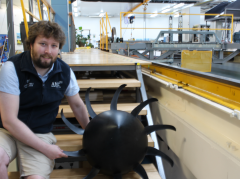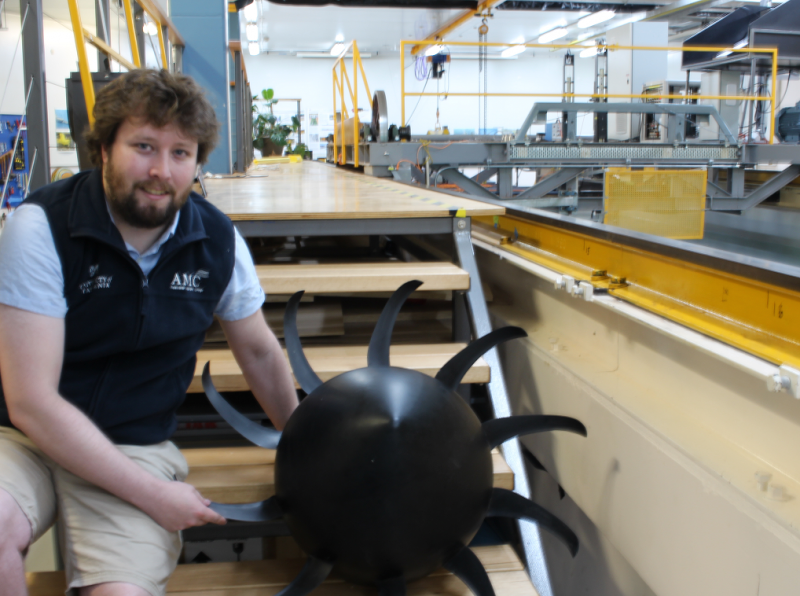
It’s been six months since the Australian Maritime College and developer MAKO Turbines installed a tidal turbine in Tasmania’s Tamar River for research and testing. Dr Tom Mitchell Ferguson has been working on the tidal turbine project since its inception. We caught up with him to find out how it’s going — and what tidal turbine research actually involves.
What research have you been doing since the tidal turbine was installed?
We’re looking at three areas: optimising the turbine, understanding its impact on the environment, and assessing the energy potential of the site where it’s deployed.
For the turbine itself, we’re looking at how it is affected by turbulence in the water and organic matter building up on it — called biofouling. These can affect the turbine’s longevity as well as its performance. By taking measurements and observations over time, we can assess the impact on how much energy is being generated.
We’re also running an environmental monitoring program to determine the effect, if any, the device has on the environment; we want to make sure that it’s not detrimental to marine life. This involves noting interactions between marine animals such as birdlife with the turbine installation.
Beyond the turbine, we’re also doing some research into the site where the turbine is deployed to determine its energy potential. We do this by measuring the turbulence in the water flow as well as the amount of water going past the device.
How do you actually measure these things?
To measure the energy in the water we use a device called an ADCP (Acoustic Doppler Current Profiler), which is installed on a separate mooring on the bottom of the river. It uses sonar (like sound waves) to measure the flow; from this we can calculate the potential energy.
On the turbine itself we have another ADCP. This allows us to compare the flow speed at the device with our other sensors located away from the barge.
It’s less hi-tech, but we also use visual observations to monitor the biofouling. It’s good for me because it means I get to go out on a boat to the site at least once a month. Here we simply observe the turbine and barge from the water and record any growth in organic matter that we see.
What else does your job involve on a day-to-day basis?
As well as monthly inspections at the site, I report on the data that we collect. All the data is stored on the sensors before being retrieved from the mooring by AMC’s vessel FTV Reviresco and processed.
My work involves identifying poor quality data and determining the key information from the measurements before reporting these to the turbine developer, MAKO.
When do you expect to finish?
The turbine will stay in the water indefinitely, and we plan to continue collecting data for as long as necessary. But we’ll be presenting the work and our results at the European Wave and Tidal energy conference in Cork, Ireland, in August.
What’s the end goal for this project?
As well as all the data that can be used to optimise their turbine, we’ll have developed processes and procedures for designing and installing the mooring that the turbine sits on. We’ll also be able to share our experiences of working in high-flow environments with industry to help improve the longevity and performance of other turbines.
Why do industry partners work with AMC on projects like this?
We focus on research at AMC, but we also have all the practical capabilities to actually get stuff built and deployed.
As well as hydrodynamics and mathematics researchers, we have our own technicians and boats — we used AMC’s FTV Reviresco to transport the turbine to the site and deploy the flow measuring instruments — and some of the best testing tanks in the world. This combination is pretty special and means a tidal energy company can draw on a broad range of knowledge and expertise.
What do you like about working on this tidal energy project?
It’s really nice to see research that was first carried out here applied in the field. I was involved with this project from its initial tank testing in January 2016. Seeing the prototype now generating power in the Tamar is excellent.
Generally, working in tidal energy is rewarding. Tidal is such a reliable and predictable source of renewable energy and it has so much potential to meet some of our energy needs in a low carbon way. It’s good to be able to make a small contribution to developing effective ways to capture the tide’s power.
Generally, working in tidal energy is rewarding. Tidal is such a reliable and predictable source of renewable energy and it has so much potential to meet some of our energy needs in a low carbon way. It’s good to be able to make a small contribution to developing effective ways to capture the tide’s power.
Published on: 29 Mar 2017
